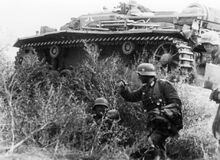Background[]
The defeat of the German army at Stalingrad was not only a physical defeat but it left a psychological scar upon the Third Reich. The loss of millions of troops, thousands of tanks and planes was a huge loss for Germany but now after the turning point at Kursk; Hitler and the German High Command wanted to make sure that this was reversed, to also make for propaganda, the 6th Army was resurrected formed with fresh but heavily trained and made into a full fighting force once again, prepared and trained specifically in dealing with Stalingrad.
Overview[]
The Second Battle of Stalingrad was a result of the decisive victory of Kursk, it was to be a very decisive battle whereby German forces were ordered to begin a fresh offensive to recapture the unconquerable city of Stalingrad. The resurrection of the German 6th army led to it being one of the greatest revenge and symbolic battles in history. The city, heavily defended as it had been two years ago, now faced once again massive German allied forces determined to avenge every single Nazi soldier killed in the first battle. Snipers and machine gun nests were initially part of the battle to resist German forces once again. However, new tactics and battalions were now to play against Soviet advantage, the Germans extensively used the Waffen-SS Suicide Squadrons rendering Soviet tanks as well as nerve gas to kill a considerable number of enemy soldiers hidden in trenches and buildings.
The Russians were able to inflict heavy German losses. However the Nazis were fully able to counter these defaults, swiftly taking out Russian positions, halting offensives and burning out Russian soldiers hidden in buildings. As in the first battle, the Luftwaffe pounded the cities infrastructure, bombing mass targets of buildings, hospitals and schools.
Causes of the conflict[]
The city of Stalingrad was no longer the target that did not just bear the name of Stalin but now bore the symbol of German defeat which Hitler wanted make sure was eliminated. Specifically deployed the German 6th army, was a major factor, German tanks, planes and heavy infantry were deployed to the city. But not before The Germans used much of its new technology i.e Nerve Gas, suicide squadrons.
Winter War[]
Although by this time the German army occupied 90% of the city, the Russians once again believed that the cold could be their ally in pushing out the Nazi invaders. This time Hitler provided full winter clothing to all German personnel as well as giving them sufficient food supplies throughout the bitter winter, much to the surprise to the Russian defenders.
War Crimes[]
The German army made a full policy to kill all who wore Soviet uniforms, regardless of age or gender.
Result[]
The battle was a clear German victory, enemy soldiers were killed to the last man, German troops then began to pillage the rest of the civilian population, taking food and burning everything down, thousands more slaughtered for revenge and the German flag finally flew over the city.

